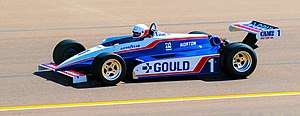Penske PC-10
The Penske PC-10 is a CART Penske Racing car which was constructed for competition in the 1982 season. Designed by Geoff Ferris, it is considered possibly the most dominant Penske race car design ever and that from a team that typically dominated. Rick Mears has been quoted as acknowledging this was his favorite racecar chassis ever.[1] Twelve total were made (1-12), six raced by Penske (1-6), with four confirmed destroyed (4, 7, 8, 11). They were manufactured at Penske Cars, Ltd. in Poole, England during 1982, and delivered to Penske Racing, Inc., in Reading, Pennsylvania. So outstanding was the PC-10's design, it won the prestigious Louis Schwitzer Award for innovation and engineering excellence in the field of race car design at the Indianapolis 500 in 1982. The PC-10s were active in the years 1982-1984. In fact, the PC-10 was ultimately much better than the following year PC-11, so Roger Penske bought back one of the PC-10s he had sold to another team for the 1983 season, and which then won another race for his team.
 | |
| Category | CART IndyCar |
|---|---|
| Constructor | Penske |
| Designer(s) | Geoff Ferris |
| Predecessor | Penske PC-9 |
| Successor | Penske PC-11 |
| Technical specifications | |
| Chassis | Aluminum Monocoque |
| Suspension | Inboard springs and Fox shocks front and rear, operated by top rocker arm with front and lower rear A arms of streamline tubing |
| Engine | Cosworth DFX 2,650 cc (161.7 cu in) V8 80° Mid-engined, longitudinally mounted |
| Transmission | Hewland V.G. 4 speed manual |
| Weight | 1,550 lb (703.1 kg) |
| Fuel | Methanol, supplied by Mobil |
| Tyres | Goodyear Eagle Speedway Specials - Rear 27.0x14.5-15 - Front 25.5x10.0-15 |
| Competition history | |
| Notable entrants | Penske Racing |
| Notable drivers | Rick Mears Kevin Cogan |
The PC-10s were driven for Roger Penske by Rick Mears and Kevin Cogan in the Championship Auto Racing Teams (CART) Series in 1982. Mears campaigned the car as the GOULD CHARGE car (red-blue-white), and in which he again won the CART Championship. It carried number 1 when Mears drove it as he was also the previous year's champion in 1981. When Cogan drove the car it carried the NORTON livery (yellow-blue-white) and carried the number 4.
The PC-10s were powered by the 2.6-liter Cosworth DFX turbocharged engine, delivering as high as 840 bhp.[2] The DFX engine was the Indy car version of the highly successful 3-liter Cosworth DFV Formula One engine developed by former Lotus engineer Keith Duckworth and Colin Chapman, with financial backing from Ford for the Lotus 49 to campaign the 1967 season. This engine had 155 wins between 1967 and 1985 in F1. The DFX variant was initially developed for Indy car use by Parnelli Jones in 1976, with Cosworth soon taking over. This engine won the Indianapolis 500 ten consecutive years from 1978 to 1987, as well as winning all USAC and CART championships between 1977 and 1987. It powered 81 consecutive Indy car victories from 1981 to 1986, with 153 Indy car victories total.[3]
Racing history
1982
Mears and Cogan accumulated many many race wins and poles during this season, with Mears ultimately winning the CART Championship as he had the previous year. Mears had nine pole positions and four race wins[4] while Cogan had two pole positions. Cogan finished sixth in the championship points.
INDY 500 – PC-10’s were involved in the two most memorable moments, one at the start and one at the finish, of this historic race. Mears started the Indy 500 on the pole in his PC-10 with Cogan right next to him. Mears finished the race in second place only 0.16 seconds behind Gordon Johncock in his Patrick Racing Wildcat Mk8B #20. At the time, it was the closet Indy 500 finish.[5]
Cogan was involved in the start of the race incident with Mario Andretti and A. J. Foyt. Foyt was able to re-start the race after the red flag, but Andretti, a crowd favorite, was unable to repair his Patrick Wildcat Mk8B #40 in time. It has been suggested that Cogan broke a half-shaft under the force of acceleration due to the slower than normal start.[6] Two other cars driven by Dale Whittington and Roger Mears farther back in the pack also collided and were out of the race. Cogan was blamed for the accident that eliminated four cars from the 1982 Indy 500. Kevin’s racing career never fully recovered from this incident, although he did have his only Indy car win in 1986 and finished second in the Indy 500 that same year.
1983
Al Unser Sr. won the CART Championship driving a modified PC-10 renamed the PC-10B. Ground effects were outlawed for this year so PC-10 ground-effects side-pods were replaced with flat-bottom side-pods. He won only one race (Budweiser Cleveland 500) but had consistent high placing finishes throughout the season (10 top 5 finishes in 13 races). Mears won the Detroit News Grand Prix this same year in his PC-11 replaced PC-10B.[7]
INDY 500 – Al finished 2nd in his PC-10B and Rick finished third in a PC-11.
1984
In 1984 the Machinists Union Racing Team acquired Penske PC-10Bs for drivers Josele Garza and Roger Mears. Garza used the PC-10B for the first two races of the season and Mears used his for Indy only.
INDY 500 – Roger Mears failed to qualify.
References
- "Rick Mears – still the ultimate pro at 65". motorsport.com.
- "Ford Cosworth DFX Turbocharged Indy Car". museumofamericanspeed.com. Archived from the original on 2015-03-23.
- "Indy 500 - 100th Race". cosworth.com. Archived from the original on 2016-12-28. Retrieved 2016-12-27.
- "1982 CART Results". racing-reference.info.
- "Top five Indy 500s: No. 4 – 1982 thriller from start to finish". foxsports.com.
- "Eight days to the 100th Indy 500: 1982 race offered furious finish". sports.usatoday.com.
- "1983 CART Results". racing-reference.info.